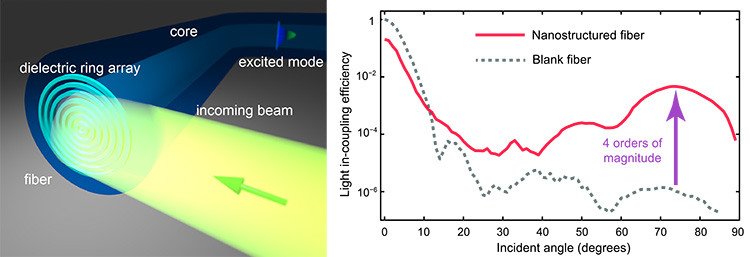 Left: All-dielectric, axially symmetric nanostructures boosted in-coupling efficiencies into optical fibers at almost a grazing incidence angle. Right: Measured in-coupling efficiency into the nanostructure-empowered functionalized fiber (solid red line) as a function of the incidence angle, demonstrating enhancement by several orders of magnitude at large angles. The dashed grey line shows the corresponding curve of a fiber with a blank facet. [Reprinted with permission from ACS Photon. 7, 2834 (2020); ©2021 ACS.]
Left: All-dielectric, axially symmetric nanostructures boosted in-coupling efficiencies into optical fibers at almost a grazing incidence angle. Right: Measured in-coupling efficiency into the nanostructure-empowered functionalized fiber (solid red line) as a function of the incidence angle, demonstrating enhancement by several orders of magnitude at large angles. The dashed grey line shows the corresponding curve of a fiber with a blank facet. [Reprinted with permission from ACS Photon. 7, 2834 (2020); ©2021 ACS.]
Optical fibers are crucial for many tasks requiring remote sensing and light collection. A key limitation of step-index fibers is their small numerical aperture, which leads to severe shortcomings in the coupling of light into the fiber modes, especially at large incidence angles.
Recently, we suggested a solution to this challenge: placing an all-dielectric nanostructure on a facet of an optical fiber.1 We found that the addition of the nanostructure allows the boosting of in-coupling efficiency by orders of magnitude. This yields enormous potential for key applications, particularly within the life sciences (for example, in vivo scanning imaging) and quantum technology (for example, single-photon collection).
Generally, when the plane end of a single-mode fiber is illuminated at angles of incidence of more than 20 degrees, only a tiny fraction of light is coupled into the fiber mode. In our work,1 we circumvented this limitation by boosting in-coupling efficiencies at large angles thanks to all-dielectric concentric ring-type nanostructures located in the core region of commercially available step-index fibers. These structures cause additional diffraction channels to emerge, which leads to a vanishing transverse phase distribution of the scattered field across the fiber end face.
We implemented accurate rings by nanostructuring silicon nitride films on the fiber end faces, using a sophisticated combination of sample planarization, wafer-based electron-beam lithography, ion-beam etching and resist removal. We were able to demonstrate record-high efficiencies for coupling of light into the resulting step-index nanostructured fibers at almost a grazing incidence angle. The measured in-coupling efficiencies of the nanostructure-empowered fibers indicated an improvement by several orders of magnitude compared with previously reported results2 and with fibers with unstructured end faces for large angles of incidence.
Researchers
Oleh Yermakov and Andrey Bogdanov, ITMO University, St. Petersburg, Russia
Henrik Schneidewind, Uwe Hubner, Torsten Wieduwilt, Matthias Zeisberger and Markus A. Schmidt, Leibniz Institute of Photonic Technology, Jena, Germany
Yuri Kivshar, Australian National University, Canberra, Australia
References
1. O. Yermakov et al. ACS Photon. 7, 2834 (2020).
2. N. Wang et al. ACS Photon. 6, 691(2019).
